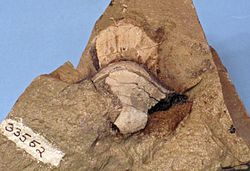| Petalodontiformes Temporal range: | |
|---|---|
 | |
| Belantsea montana | |
 | |
| Janassa bituminosa | |
| Scientific classification | |
| Kingdom: | Animalia |
| Phylum: | Chordata |
| Class: | Chondrichthyes |
| Subclass: | Holocephali |
| Order: | † Petalodontiformes Zangerl, 1981 |
| Families | |

Petalodontiformes ("thin-plate teeth") is an extinct order of marine cartilaginous fish related to modern day chimaera found in what is now the United States of America and Europe. [1]
Most species are known only from isolated teeth. [1] [2] All fossils range from the Carboniferous to the Permian, where they are presumed to have died out during the Permian/Triassic extinction event. [1]
The two best known species are Belantsea montana , from the Carboniferous Bear Gulch, Montana, and Janassa bituminosa , from the upper Permian of Europe, as whole fossil specimens have been found of these two.







